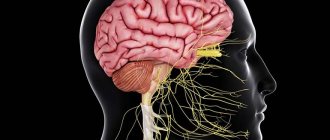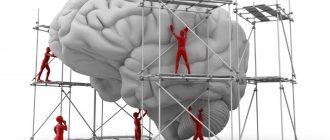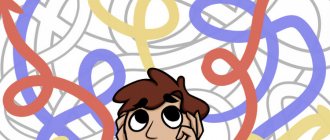Arnold Chiari malformation is a developmental disorder that consists of a disproportion between the size of the cranial fossa and the structural elements of the brain located in it. In this case, the cerebellar tonsils descend below the anatomical level and can be infringed.
Symptoms of Arnold Chiari malformation include frequent dizziness and sometimes result in a brain stroke. Signs of an anomaly may be absent for a long time, and then suddenly manifest themselves, for example, after a viral infection, a blow to the head or other provoking factors. Moreover, this can happen at any stage of life.
What is Arnold Chiari Anomaly (Syndrome)
Arnold Chiari syndrome (anomaly) is a congenital pathology of the development of the rhombencephalon. Abnormal brain development is a discrepancy between the size of the posterior cranial fossa and the brain structures in this area. Such a defect subsequently causes prolapse of the brain stem, as well as the cerebellar tonsils, into the foramen magnum of the occipital bone and leads to their infringement. In addition, the child has hydrocephalus and pathological development of the spinal cord. Since wedged brain structures, in particular the cerebellum, block the physiological circulation of cerebrospinal fluid, hydrocephalus of the brain develops.
Diagnostics
The diagnosis of type 1 anomaly is not accompanied by spinal cord damage and is made mainly in adults using CT and MRI. According to the pathoanatomical autopsy, in children with spinal canal hernia, Chiari disease of the second type is detected in most cases (96–100%). Using ultrasound, you can determine disturbances in the circulation of cerebrospinal fluid. Normally, cerebrospinal fluid circulates easily in the subarachnoid space.
Downward displacement of the tonsils impedes circulation. Due to impaired fluid dynamics, hydrocephalus occurs.
Lateral X-ray and MR picture of the skull shows the expansion of the spinal canal at the level of C1 and C2. On angiography of the carotid arteries, the cerebellar artery bends around the tonsil. X-rays show concomitant changes in the craniovertebral region, such as underdevelopment of the atlas, odontoid process of the epistrophe, and shortening of the atlanto-occipital distance.
With syringomyelia, a lateral X-ray image shows underdevelopment of the posterior arch of the atlas, underdevelopment of the second cervical vertebra, deformation of the foramen magnum, hypoplasia of the lateral parts of the atlas, enlargement of the spinal canal at the C1-C2 level. Additionally, MRI and invasive x-ray examination should be performed.
MRI is the most preferred diagnostic method
The manifestation of symptoms of the disease in adults and the elderly often becomes the reason for identifying tumors of the posterior cranial fossa or craniospinal region. In some cases, the patient’s external manifestations help to make a correct diagnosis: low hairline, shortened neck, etc., as well as the presence of craniospinal signs of bone changes on X-rays, CT and MRI.
Today, the “gold standard” for diagnosing the disorder is MRI of the brain and cervicothoracic region. It is possible to perform intrauterine ultrasound diagnostics. Possible ECHO signs of abnormality include internal dropsy, a lemon-shaped head, and a banana-shaped cerebellum. At the same time, some experts do not consider such manifestations to be specific.
To clarify the diagnosis, different scanning planes are used, thanks to which several informative symptoms in the fetus can be detected regarding the disease. Obtaining an image during pregnancy is quite easy. In view of this, ultrasound remains one of the main scanning options to exclude pathology in the fetus in the second and third trimesters.
Identification of signs of the disease in the fetus can be an indication to exclude malformations of the spinal column, however, even the absolute absence of ultrasound data indicates spina bifida in 95% of cases.
Types of Arnold-Chiari syndrome
According to the modern classification, there are four types of Arnold Chiari syndrome:
- Arnold Chiari malformation type 1 is characterized by displacement of the anatomical structures of the posterior cranial fossa into the spinal canal.
- Arnold Chiari malformation type 2 is characterized by displacement of the posterior parts of the cerebellar vermis, fourth ventricle and medulla oblongata.
- The third type is characterized by either a strong displacement of all structures of the posterior cranial fossa into the spinal canal.
- The fourth type of disease is determined by underdevelopment of the cerebellum without its dislocation into the spinal canal.
The last two types of disease are incompatible with life.
Very often, patients with Arnold Chiari syndrome have concomitant spinal pathology, which occurs when there is strong pressure from the anatomical structures of the posterior cranial fossa on the cervical spine. Such a pathology is spinal cysts. They can be large and often cause symptoms of spina bifida (severe pain, dysfunction of internal organs).
- Surgery
- Oncology
- Neurosurgery
- Radiology and Radiation Therapy
- Gynecology and new reproductive technologies
- Traumatology and Orthopedics
- Cardiology
- Neurology
- Laser surgery
- Urology, andrology and microsurgery
- Plastic surgery
- Mammalogy
- Lithotripsy
- Psychological support service
- ECO
- Weight loss
- Pressure chamber
- Endovascular surgery
- Pituitary adenomas
- Arnold-Chiari malformation and syringomyelia
- Parkinson's disease
- Hydrocephalus
- Hemifacial spasm
- Herniated discs
- Violent movements
- Brain tumors
- Vascular diseases of the brain
- Trigeminal neuralgia
- Glossopharyngeal neuralgia
- Essential tremor
Arnold-Chiari malformation is a malformation of the cervico-medullary junction, characterized by displacement of the cerebellar tonsils and, in some cases, the trunk and IV ventricle below the level of the foramen magnum.
Types of malformation
Chiari malformation type I is a displacement of the cerebellar tonsils down through the foramen magnum to the upper parts of the spinal cord. This type of malformation is accompanied by hydromyelia and usually appears in adolescence or adulthood. In adolescents, the main symptoms are impaired flexion and decreased strength in the arms, loss of pain and temperature sensitivity in the upper half of the body and arms. Adults usually complain of pain in the cervical-occipital region, which increases with coughing, as well as pain in the arms.
Chiari malformation type II is characterized by displacement of the cerebellar vermis, tonsils, fourth ventricle, and medulla oblongata (part of the brain stem) into the foramen magnum. This type, also called Arnold-Chiari malformation, is much more often accompanied by hydromyelia than type I and is almost always associated with myelomeningocele. Myelomeningocele is a congenital disorder of the closure of the spinal cord and spine during fetal formation. Symptoms of this malformation are obvious and usually appear immediately after birth, along with short episodes of cessation of breathing, a decreased pharyngeal reflex, involuntary and rapid downward movements of the eyeballs, and decreased strength in the arms.
Chiari malformation type III consists of displacement of the cerebellum and part of the brain stem with meninges into a meningocele, located in the cervico-occipital region.
Arnold-Chiari malformations of types II and III may be accompanied by signs of dysplasia of the nervous system: polymicrogyria, heterotopia of the cortex, hypoplasia of the subcortical ganglia, dysgenesis of the corpus callosum, pathology of the septum pellucidum, thickening of the interthalamic junction, beaking tectum (coracoid tectum), the presence of an inflection of the Sylvian aqueduct is often noted ( 55%), cysts of the foramen of Magendie, hypoplasia of the falx and tentorium of the cerebellum, hemivertebrae, low location of the caudal part of the spinal cord at the level of LIV–V vertebrae and below.
Etiology of the disease
The etiology of the disease is currently unclear. There is evidence indicating the role of a genetic factor in the etiology of this syndrome. Ectopic cerebellar tonsils into the foramen magnum were found in three monozygotic twins. Since the first description of Cleland's malformation in 1883, several theories have emerged. The theory, supported by the studies of Misao Nishikawa et al., is that due to paraxial dysplasia of the mesodermal layer or primary damage to the structures of the corresponding somite, an abnormally small posterior cranial fossa is formed, the hindbrain structures, filling the volume of the posterior cranial fossa and continuing to grow, descend into the occipital channel. The combination of Chiari malformation type II with meningomyelocele is due to the fact that the degree of paraxial dysplasia of the mesodermal layer in AK - II type is more pronounced than in AK - I type and is noted not only at the level of the occipital bone formation, but also along the body axis at the level of row formation vertebrae, which manifests itself in spina bifida, as well as in anomalies of a number of other bone structures and the skeletal system as a whole.
Clinic
Clinical manifestations of type I AK appear most often in adolescence or adulthood. These manifestations fit into such neurological syndromes as cerebellobulbar, liquorohypertensive, syringomyelic, and cranial nerve injury syndromes. Liquorhypertensive syndrome is manifested by headache, usually suboccipital, and neck pain, aggravated by coughing, sneezing and straining, congestive optic discs. Stem disorders and disorders of the functions of cranial nerves manifest themselves in the form of unstable oscillopsia, trigeminal dysesthesia, hearing loss, tinnitus, dizziness, dysphagia, respiratory arrest during sleep, periodic fainting (often associated with coughing), impaired control over heart rate, blood pressure during transition from a horizontal to a vertical position, atrophy of half the tongue, paralysis of the vocal cords, stridor, spastic or combined (more in the upper extremities) tetraparesis may be observed.
Cerebellar disorders - nystagmus, dysarthria, ataxia. Symptoms associated with syringomyelic cysts are numbness, sensitivity disorder, usually of a dissociated type, as well as neuroarthropathy, dysfunction of the pelvic organs, absence of abdominal reflexes, muscle wasting. At the same time, a number of authors note a discrepancy between the localization, extent of the cyst, cystic index (the ratio of the anteroposterior size of the cyst to that of the diameter of the spinal cord at the level of the cyst), on the one hand, and the zone of hypoesthesia, the prevalence of segmental disorders of surface sensitivity, the severity of muscle wasting and the degree of paresis - with another. AK type II manifests in newborns and early childhood with symptoms such as apnea, stridor, bilateral vocal cord paresis, neurogenic dysphagia with nasal regurgitation, cyanosis during feeding, nystagmus, hypotonia, weakness, spasticity in the upper extremities, which can progress up to to tetraplegia. Chiari malformation type III is rare, its clinical manifestations are the same as in AK II.
Diagnostics
Standard X-ray examination can reveal only indirect signs of AC malformation; computed tomography also does not provide clear visualization of soft tissue structures. The widespread introduction of MRI into clinical practice has solved most of the problems associated with the diagnosis of Chiari malformation. This was facilitated by good visualization of the structures of the posterior cranial fossa, craniovertebral junction, spinal cord, and the absence of artifacts from bone structures.
MRI of a patient with type I AK and sigingomyelia.
Posterior fossa landmarks used in the diagnosis of AK. d + e = slope length; S = sphenooccipital synchondrosis; d = length of the base of the sphenoidal platform from the dorsum sella and sphenooccipital synchondrosis to the clivus; e = length between synchondrosis and basion; b = length of the brainstem between the plane of the midbrain-pons junction and the medullocervical junction; a = angle of tentorium cerebellum relative to Twining's line; c = cerebellar hemisphere length; DS = apex of the dorsum sella; IOP = internal occipital prominence; OP = opisthion; B = basion; TW = Twining line; McR (B to OP) = McRae's line. (borrowed from Dimensions of the posterior fossa in patients symptomatic for Chiari I malformation but without cerebellar tonsillar descent, Raymond F Sekula et al.).
| Indicators | in patients with AK - I | in healthy individuals |
| Clivus (d+e) | 32.95 ± 8.7 | 43.00 ± 6.6 |
| Supraocciput (IOP to OP) | 40.50 ± 5.9 | 41.80 ± 6.2 |
| Basisphenoid (d) | 18.63 ± 5.3 | 23.64 ± 4.9 |
| Basiocciput(e) | 14.00 ± 4.3 | 19.36 ± 4.7 |
| Hindbrain(b) | 47.05 ± 4.1 | 46.40 ± 4.4 |
| Cerebellum (c) | 47.36 ± 7.9 | 47.04 ± 4.8 |
| McRae's (B to OP) | 43.55 ± 4.9 | 42.52 ± 5.9 |
| Twining's (DS to IOP) | 84.55 ± 7.8 | 87.32 ± 6.6 |
| Tentorial Angle (a) | 41.27 ± 6.5 | 34.84 ± 7.2 |
Surgery
Treatment of Chiari malformation and concomitant syringomyelia is only possible through surgery. The operation consists of decompressing the posterior cranial fossa or installing a cerebrospinal fluid shunt for concomitant hydrocephalus. Local decompression is performed under general anesthesia and consists of removing part of the occipital bone, as well as the posterior halves of the first and/or second cervical vertebrae to the place where the cerebellar tonsils descend. The descended cerebellar tonsils are also resected, thereby eliminating compression of the brain stem. This effective surgery widens the foramen magnum and relieves compression of the brain stem, spinal cord and cerebellar tonsils. The surgery also opens the dura mater, the thick membrane that surrounds the brain and spinal cord. A patch made of other tissue (artificial or taken from the patient) is sewn into the open dura mater for more free passage of cerebrospinal fluid.
Intraoperative photography. Chiari malformation type I. 1 - dystopic tonsils of the cerebellum, causing compression of the brain stem and upper parts of the spinal cord.
Intraoperative photography. Chiari malformation type I after surgical correction. 1 — cerebellar tonsils are resected and sutured with subpial sutures to the dura mater, 2 — lumen of the fourth ventricle, 3 — superior parts of the spinal cord, compression is eliminated. Less commonly, operations are performed to drain cerebrospinal fluid from the enlarged spinal cord into the chest or abdominal cavity using a special hollow shunt with a valve or into the intrathecal space. Sometimes these operations are performed in stages.
The effectiveness of surgical decompression ranges from 50 to 85% according to various authors. It must be remembered that surgical treatment is best carried out before the development of severe neurological disorders, since after surgical treatment the restoration of functions does not occur completely or does not occur at all, and the main goal of surgery is to stabilize the patient’s neurological status and prevent further progression of the disease.
Reasons for the development of Arnold Chiari malformation
The exact pathogenesis of the malformation is not fully known. But there are several key pathogenetic development factors: genetically determined congenital osteoneuropathy, damage to the skull bones as a result of birth trauma, hydrodynamic shock in the spinal canal.
Today, doctors identify several reasons that can lead to the development of this defect:
- unfavorable factors that affect a pregnant woman;
- taking medications during pregnancy;
- smoking and alcoholism during pregnancy;
- viral infectious diseases of a pregnant woman.
Symptoms and clinical picture
Many people suffering from this developmental pathology may not even be aware of its presence. Usually, they are diagnosed accidentally and do not require any treatment.
The remaining patients have more or less severe symptoms of the disease. The disease is accompanied by pain in the cervical-occipital region of the head, which tends to intensify with coughing, hiccups, and also with sneezing. A neurologist finds a decrease or complete absence of pain and temperature sensitivity of the upper extremities, muscle weakness and spasticity of the extremities. Also, fainting and dizziness are observed, there may be decreased vision, episodic apnea, and involuntary rapid eye movement. An increase in intracranial pressure is characterized by morning pain in the head, a feeling of hissing and ringing in the ears. Deterioration in coordination is manifested by tremor of the upper or lower extremities. As the disease progresses, the patient develops problems with urination, weakness and general fatigue increase. During movement, the clinical picture becomes more vivid.
associated risks
Chiari can create a number of dangers for people suffering. Because it pushes the cerebellum of the amygdala down, the base of the brain is subjected to higher than normal pressure, which can cause certain neurological problems. Additionally, in some cases the condition causes the passage of the cerebrospinal fluid to be blocked. This is a serious problem because this protective fluid contains all the nutrients needed to nourish the brain and also removes waste.
Possible complications
Uncontrolled progression of the disease is fraught with significant complications. They do not occur in all patients, but sometimes they still occur. These include:
- Hydrocephalus, which requires a shunt and drainage of excessive cerebrospinal fluid.
- Paralysis can occur due to compression of certain structures of the spinal cord.
- Syringomyelia is a spinal disease characterized by the appearance of cystic formations in the spinal cord. Cysts filled with fluid can disrupt the functions of the spinal cord.
- Bone defects of the cervical vertebrae.
Symptoms of the disease
If we talk about the clinical manifestations of the disease, then most often we have to remember the pathology of the 1st degree. Its first manifestations can make themselves felt only during puberty; changes are often noticed by older people. As is the case with other brain pathologies, the first signal and cause for concern may be a headache, especially if it does not disappear even after exposure to painkillers. By the way, the symptoms may vary depending on the physical condition of the person, his gender and age, but quite often these are a shaky gait, problems with fine motor skills of the hands (the inability to perform basic housework), numbness of the limbs, pain in the neck area.
Diagnosing Arnold-Chiari malformation is a very difficult task, but it can be solved, and modern diagnostic methods come to the rescue, including computed tomography and magnetic resonance imaging, and MRI is especially effective in this case. A routine neurological examination will only determine the presence of hydrocephalus (high intracranial pressure). In this case, X-rays are also powerless, recording only a violation of the condition of the skull. Quite often the disease does not manifest itself, so the diagnosis is not always made in a timely manner, just as the treatment of Arnold-Chiari malformation is not started in a timely manner. In Moscow, many institutions are engaged in this, but the best results are demonstrated by specialists from the oldest neurosurgical institution - the Scientific and Practical Center named after. Burdenko.
Diagnostic tactics
If the patient has certain complaints or a developmental anomaly was discovered by chance, he should contact a qualified neurologist for further diagnosis and treatment. The neurologist will take a medical history, conduct a full examination of the patient, and assess his neurological status. To make a final diagnosis, Israeli specialists use the following diagnostic methods:
- X-ray examination of the skull reveals only bone abnormalities.
- MRI of the brain and spinal cord, as well as CT using contrast, demonstrates the presence of abnormalities in the development of bone tissue and reveals a violation of the location of the soft tissues of the brain.
- Echo-EG, EEG and REG provide information about the state of intracranial pressure.
Consequences and prognosis for life
Once the diagnosis is confirmed, treatment should begin as soon as possible. Certain diagnostic problems may arise due to the asymptomatic course of the disease. Chiari malformation grade 3 is often fatal. But timely surgical treatment allows you to avoid adverse consequences. The operation is the gold standard of modern neurosurgery.
Even minor neurological manifestations are an indication for contacting specialists. Ideally, treatment should begin immediately after the pathology is identified. The disease in its advanced form ends in disability and death of the patient.
Timely treatment using surgery allows you to avoid irreversible atrophic processes in the central nervous system. At the Burdenko Research Institute, such surgical interventions are performed at a high professional level. Experienced neurosurgeons work with patients, paying special attention to each stage of treatment, including preparation for surgery and conducting a thorough comprehensive examination.
After surgery, patients are under the supervision of neurosurgeons, rehabilitation specialists, and resuscitators. Specialists monitor vital signs of the body. If necessary, professionals provide first aid and slow down the development of complications and other adverse health consequences. Modern techniques used in neurosurgery make it possible to reduce the degree of tissue damage during work with the brain and avoid unnecessary injuries and blood loss.
Arnold Chiari malformation - treatment in Israel
Treatment for each patient depends on a number of factors. These include the type of abnormal development, duration of the disease, severity level, as well as the results of all diagnostic procedures of the patient and his individual characteristics. Based on these data, the neurologist prepares an individual treatment.
If the basis of the clinical picture is a minor headache, then conservative treatment with anti-inflammatory drugs and muscle relaxants can be completely done. And if the disease progresses and conservative therapy is ineffective or ineffective, then you need to turn to operative surgical treatment.
During the operation, the neurosurgeon eliminates compression of the nerve fibers and restores normal circulation of the cerebrospinal fluid. To do this, he needs to enlarge the posterior cranial fossa. If the operation is successful, the patient feels much better, breathing, motor functions and sensitivity return to normal. Specialists at Israeli clinics take a comprehensive approach to the treatment of Arnold-Chiari syndrome; each patient receives an individual, most appropriate treatment regimen.
Treatment
In asymptomatic cases, constant monitoring with regular ultrasound and radiographic examination is indicated. If the only sign of an abnormality is minor pain, the patient is prescribed conservative treatment. It includes a variety of options using non-steroidal anti-inflammatory drugs and muscle relaxants. The most common NSAIDs include Ibuprofen and Diclofenac.
You cannot prescribe painkillers yourself, as they have a number of contraindications (for example, peptic ulcer). If there is any contraindication, the doctor will select an alternative treatment option. Dehydration therapy is prescribed from time to time. If there is no effect from such treatment within two to three months, surgery is performed (expansion of the foramen magnum, removal of the vertebral arch, etc.). In this case, a strictly individual approach is required to avoid both unnecessary intervention and delays in surgery.
Treatment tactics for each patient require an individual approach
In some patients, surgical exploration is the way to make a definitive diagnosis. The purpose of the intervention is to eliminate compression of the nerve structures and normalize cerebrospinal fluid dynamics. This treatment results in significant improvement in two to three patients. The expansion of the cranial fossa helps to eliminate headaches and restore tactility and mobility.
A favorable prognostic sign is the location of the cerebellum above the C1 vertebra and the presence of only cerebellar symptoms. Relapses may occur within three years after the intervention. Such patients are assigned a disability by decision of the medical and social commission.
Preventive measures
Prevention of the occurrence of the syndrome lies in the careful attitude of the pregnant woman to her health and the health of the baby. She is advised to eat healthy foods and stop smoking and drinking alcohol. The recommendations of the attending physician must be followed in full, this also applies to taking medications. All this will help reduce the likelihood of developmental defects in the baby to a minimum.
Arnold Chiari syndrome is a very rare birth defect. But with timely diagnosis and treatment of this disease, you can almost completely get rid of neurological manifestations and become a healthy person. Therefore, it is so necessary to promptly contact highly specialized clinics, such as Israeli clinics.
In children
The block most commonly noted is within the ventricular system and is noncommunicating hydrocephalus . This is usually caused by a narrowing of the Sylvian aqueduct or underdevelopment of the foramina of Magendie and Luschka. As a generalized disorder of the development of the nervous system, it can be combined with micro- or macrogyria, porencephaly, agenesis of the corpus callosum, fusion of the cerebral hemispheres, agenesis of the cerebellar vermis, vertebral clefts, meningocele, encephalocele, syringomyelia, hydromyelia . The cause of communicating hydrocephalus may be the formation of adhesions in the subarachnoid region at the base of the brain, perinatal subarachnoid or intraventricular hemorrhages.
The syndrome in children can occur as a result of traumatic injuries to the sphenoid-occipital and sphenoid-ethmoid region due to birth injuries. Clinical manifestations include feeding disorders ( reflux and aspiration ), episodes of apnea , stridor , cranial innervation disorders, and seizures resistant to anticonvulsants.
Arnold Chiari syndrome in the fetus
Chiari pathology is a congenital osteoneuropathy and is formed at the stage of formation and development of the neural tube in the fetus, asynchronous formation of the nerve trunk and bones of the cranial fossa.
The morphological manifestations of this pathology can be identified during an ultrasound examination and determine the further prognosis. Most often, the detection of pathology becomes the reason for termination of pregnancy.









